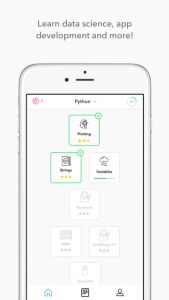I like trying out new gamified applications, to see how designers have used gamification. On the recommendation of Andrzej, I tried out a teaching to code application called Py. I have to say I love the simplicity of the gamification and how it motivates the learner forward. Before you enter the application on a laptop, you go through a confidence boosting sequence to show you coding is easy. Even if you know how to code already, it’s fun to see how simple reinforcements make you feel good about something that a lot of people find daunting to learn.
The application starts by asking you which coding language you want to learn. You can select as many as you like on the mobile application and give an indication of your level of competence in each. Once selected you can start your first free to learn lessons. Somewhere after the first lesson you are also asked about your personal preferences on how much time you want to dedicate to learning each day, I chose 3 minutes, knowing my schedule at times, coffee length is good. Then it measures your streaks or daily goal achievements against your own chosen goal. It is rare to have your personal preferences measured and yet very motivational.
 The lessons are small bite-size chunks that I can complete in my daily goal time or close to it. The visual progression layout, gives a clear indication as to how far you have come. As you complete a lesson the visual grey box turns green and you move forward. Inside each lesson you will have an element of teaching and then immediately putting the learning into practise, sometimes by simply running the code to see how it works other times really testing if you are following the concept that was just explained. Each item you get wrong, gives immediate constructive feedback, but no opportunity to immediately retry and sometimes I knew the moment I pressed the run button that I had chosen the wrong answer. I think it is actually good to not give me an immediate chance to re-take it, but force me to wait until I complete the lesson. Learning that failing sometimes is part of learning.
The lessons are small bite-size chunks that I can complete in my daily goal time or close to it. The visual progression layout, gives a clear indication as to how far you have come. As you complete a lesson the visual grey box turns green and you move forward. Inside each lesson you will have an element of teaching and then immediately putting the learning into practise, sometimes by simply running the code to see how it works other times really testing if you are following the concept that was just explained. Each item you get wrong, gives immediate constructive feedback, but no opportunity to immediately retry and sometimes I knew the moment I pressed the run button that I had chosen the wrong answer. I think it is actually good to not give me an immediate chance to re-take it, but force me to wait until I complete the lesson. Learning that failing sometimes is part of learning.
If you had wrong answers, you have a review button activated at the end of a lesson and it asks nicely “review if you would like to complete the lesson with three stars”, aka allowing all learners to feel they can earn top marks. In my view this is good confidence building which is good to balance the consequence of not getting something right first time.
From a gamification design perspective, the mechanics used are sparse, yet very appropriate and in my view they facilitate the learning objectives of the individual.
I have to say it is the first time I have managed to keep up a daily learning streak and I actually look forward to completing it every day. It is one of those easy controllable factors that give me a positive boost.


